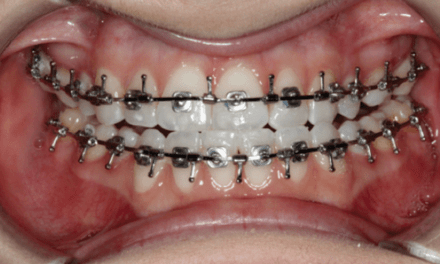
Orthodontic Products asked four orthodontists in private practice—Michael C. Alpern, DDS, MS; Howard A. Fine, DMD, MMSc; Theodore Freeland, DDS; and Neal D. Kravitz, DMD, MS—their take on the issue and how they handle patients with TMJ.
Why do you or do you not include TMJ diagnosis and treatment as part of your orthodontic treatment for children and/or adults?
Alpern: In 36 years of clinical practice, I have found that 75% of the children and adults who present with malformations of the teeth and jaws also have TMJ symptoms. Therefore, in my initial orthodontic examination, I include an extensive series of TMJ questions, and I perform a TMJ clinical examination. As I state in my textbook, The Ortho Evolution, “Teeth and jaws affect the TMJs; the TMJs affect the teeth and jaws; and orthodontics affects both.”
Fine: In our office, we routinely perform a TMJ exam on all child and adult patients. We screen for TMJ noises, including clicking and crepitus, limitation of opening, and deviation upon opening. Basically, we are looking for gross indication of disc displacement. We note the findings in the chart and provide a report to the referring dentist.
Freeland: Yes, I do include a complete TMJ examination to make sure I am starting my orthodontic diagnosis from a seated condylar position. If there are joint noises, muscle soreness, difficulty in seating the condyles, and muscle splinting, there is good chance the malocclusion you see in the mouth is not accurate. It’s much worse. This is the main reason a patient’s malocclusion gets worse when the practitioner is in the middle of orthodontic treatment. Also, by including TMJ knowledge, the adolescent/adult patient with DJD can be differently diagnosed and the proper imaging techniques prescribed, along with the proper treatment protocol.
Kravitz: We certainly perform clinical TMD diagnosis as part of our routine initial orthodontic treatment. We want to determine if the patient presents with myofascial pain, internal derangement, condylar degeneration, or worse. Patients with myofascial pain or anterior disc displacement with reduction (ADDR) may be treated with a gneuromuscular orthotic prior to braces as a palliative means of alleviating symptoms. However, we do not believe that patients with debilitating TMD are suited for routine orthodontic care.
In the past, one question has been discussed and debated: Are orthodontists to be the “keepers of the condyles”? What is your take on this question?
Alpern: I believe we, as orthodontists, can affect the TMJs. However, my opinion and research has found that quite often, the patient’s unintentional destructive habits (leaning on their jaws, biting fingernails, chewing ice and objects) can be major causes of TMJ internal derangements and degenerative joint disease. In my experience, all the splint and occlusal efforts may fail if we do not also address these destructive habits. Often, a PhD clinical neuropsychologist is very helpful in training and assisting the stopping of destructive habits. Patients and parents should keep in mind that destructive habit control training is two steps forward and one step back. Patience and perseverance is important.
My hypothesis is that the head (with brain and spinal fluid), the neck, and shoulders can weigh approximately 15 to 20 pounds. The mandible is suspended from the skull by muscles, ligaments, and tendons. This Visco-elastic tissue is not capable of tolerating a teenager or adult constantly leaning on their lower jaw for hours and hours a day. As orthodontists and/or dentists, we would not consider placing this kind of force on the mandible for hours and hours per day. Thus, we are only partially the “keepers of the condyles.” Patients are also responsible for their condyles by addressing destructive habit control training.
Fine: TMJ problems can be multifactorial. As dentistry is more multidisciplinary, and orthodontists are doing more cases in conjunction with other specialties such as perio and prosthetics, TMJ issues are not the sole responsibility of the orthodontist. Each of the treating practitioners of a patient, whether medical or dental, have to be aware of TMJ issues and be prepared to treat them or make the appropriate referral. As an example, Lyme disease is prevalent in the Northeast, and patients can present with acute TMJ problems that are part of what is known as Lyme’s arthritis. Clearly, the problem is treated within the medical field, but all dental practitioners have to be aware of the condition and make the appropriate assessments.
Freeland: Absolutely! The orthodontic field is the only endeavor that on a routine basis moves 28 teeth in three dimensions and must match them up with joints that can move in
6 degrees of freedom. If the new tooth position is not in harmony with joint function, the entire gnathic system will fail. Just ask the restorative dentist the type of cases he/she has to perform a total rejuvenation on: postorthodontic cases.
Kravitz: Oh, Roth, where art thou? I do believe that condylar “diagnosis” is important, meaning it is important to understand the severity of the Class II malocclusion prior to starting treatment. However, condylar “treatment” is truly a Roth philosophy and one to which I am not sure I fully prescribe. There is significant research available, including wonderful studies by Donald J. Rinchuse, DMD, MS, MDS, PhD, and Charles S. Greene, DDS, regarding the variability and adaptability of the condyle. Should we eliminate Class II directional elastics from our treatment modality? After all, we cannot prescribe mandibular advancement to every retrognathic patient we treat. So are orthodontists the “keepers of the condyle?” No, I think the condyles are keeping just fine on their own.
Do you believe that orthodontic treatment can affect a patient’s TMJs?
Alpern: In the last 20 years, I have found that approximately 90% of my patients who present with TMJ symptoms have fewer symptoms after Rapid Palatal Expansion (RPE) Bite Plane treatment, if they simultaneously stop all TMJ destructive habits (as mentioned in the second question). RPE with bite plane treatment can also expand the Lateral Pterygoid plates. The Lateral Pterygoid plates are the origin for the Lateral Pterygoid muscles. These muscles pull medially and anteriorly where they insert into the TMJ discs and the fovea of the head of the condyles. My published hypothesis, for over 20 years, has been that this expansion of the Lateral Pterygoid plates can potentially adjust the “tonus” of the Lateral Pterygoid muscles. This can permit “disc readjustment.” This hypothesis may be the reason that 90% of my patients have less TMJ symptoms after expansion and stabilization.
Fine: It has long been debated whether orthodontic treatment can affect a patient’s TMJ, either positively or negatively. Since TMJ issues are multifactorial and can be cyclical, the correlation between orthodontic treatment alone and TMJ is hard to establish. Again, all treating practitioners have to be aware of the patient’s TMJ condition and be prepared to help treat any conditions or make the appropriate referrals. Different modalities treat TMJ differently, and one should assume that all can have a difference on the joint. The old joke is that if a dental school has different floors for different specialties, TMJ treatment will differ depending on which floor the patient exits the elevator.
Freeland: A resounding yes, but in a negative direction. If orthodontics leaves balancing interferences or a posterior fulcrum, the osseous components of the joint will change in a negative way. A number of researchers have shown that the shape of the condyles can be affected by the created malocclusion.
Kravitz: Sure, there may be a connection, though I am not sure if it is a direct cause-effect connection. We tell our patients that orthodontics may help, may worsen, or may keep their current TMD condition. I do believe that muscle activity and peripheral factors such as stress and anxiety do have a significant role. In the mouth, the muscle wins.
Is there any orthodontic treatment procedure that could have a positive effect on your patients’ TMJs? If yes, what procedure do you recommend?
Alpern: My answer to the previous question applies to this question also.
Freeland: If you mean, “is there any mechanic system” that will be a positive influence on the joints: transpalatal arches that help eliminate posterior vertical dysplasias improve joint musculature. The only other procedure that has a positive influence is gnathologic splint therapy. With the proper design (a mutual protected occlusion), the muscle of mastication will relax, allowing the condyles to seat.
Kravitz: Patients with TMD due to myofascial pain seem to respond positively to maxillary incisor proclination and overbite reduction, allowing for greater protrusive slide. These patients often complain of a sensation of a “tight” bite and a feeling that their upper teeth are “shoving their lower jaw backward.”
If you do not include TMJ symptoms as part of your orthodontic diagnosis and treatment, then who do you refer to if your patient develops TMJ symptoms during orthodontic treatment?
Alpern: I believe that orthodontists are true occlusion experts and, most of the time, they are the most appropriate professionals to treat TMJ symptoms. However, due to the complexity of TMJ symptoms, additional expertise is required. The general dentist, a board-certified neurologist, and a PhD neuropsychologist are critical members of the team. The orthodontist is only one member of this team.
Fine: We are fortunate to have at least three local practitioners who have focused their practices on TMJ. This means that there are excellent sources for more complicated TMJ issues. Therefore, for anything beyond simple appliances such as flat-plane splints to prevent muscle-related TMD, we rely on these colleagues.
Freeland: Why would you not include a complete TMJ examination? If the orthodontic profession wants to continue as a health profession, then the complete gnathic system has to be analyzed. By doing so, the patients who are prone to developing TMJ problems during treatment can be eliminated before starting definitive treatment. By including the whole system, the practitioner will be able to tell which patients and their joints will respond to occlusal correction and which patients are internal deranged and will get worse during bite correction therapy.
Kravitz: We work closely with a number of restorative dentists who treat TMD. We work with these groups because they prescribe a conservative, palliative treatment such as TENSING, muscle relaxers, anti-anxiety medications, and mandibular advancing orthotics, rather than surgery. In essence, the best “treatment” for a majority of patients suffering from TMD is actually “management” with conservative approaches. OP





